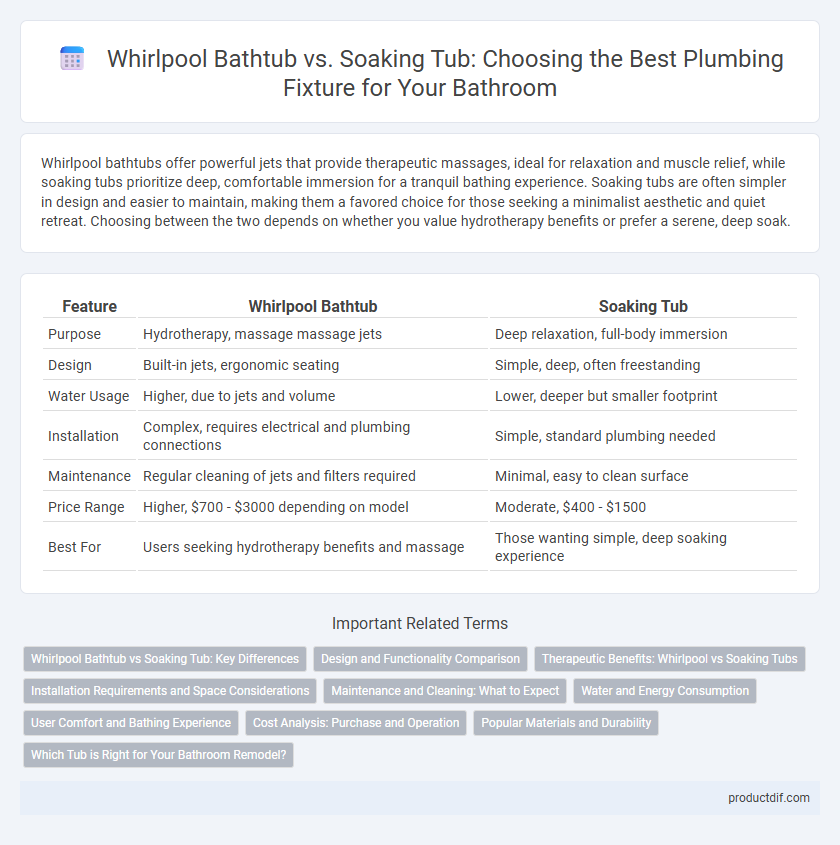Whirlpool bathtubs offer powerful jets that provide therapeutic massages, ideal for relaxation and muscle relief, while soaking tubs prioritize deep, comfortable immersion for a tranquil bathing experience. Soaking tubs are often simpler in design and easier to maintain, making them a favored choice for those seeking a minimalist aesthetic and quiet retreat. Choosing between the two depends on whether you value hydrotherapy benefits or prefer a serene, deep soak.
Table of Comparison
| Feature | Whirlpool Bathtub | Soaking Tub |
|---|---|---|
| Purpose | Hydrotherapy, massage massage jets | Deep relaxation, full-body immersion |
| Design | Built-in jets, ergonomic seating | Simple, deep, often freestanding |
| Water Usage | Higher, due to jets and volume | Lower, deeper but smaller footprint |
| Installation | Complex, requires electrical and plumbing connections | Simple, standard plumbing needed |
| Maintenance | Regular cleaning of jets and filters required | Minimal, easy to clean surface |
| Price Range | Higher, $700 - $3000 depending on model | Moderate, $400 - $1500 |
| Best For | Users seeking hydrotherapy benefits and massage | Those wanting simple, deep soaking experience |
Whirlpool Bathtub vs Soaking Tub: Key Differences
Whirlpool bathtubs feature built-in jets that provide massaging water streams, promoting relaxation and hydrotherapy benefits, whereas soaking tubs prioritize deep water capacity for full-body immersion without jets. Whirlpool tubs typically require more complex plumbing and electrical systems, increasing installation and maintenance requirements compared to soaking tubs, which have a simpler design focused on comfort and depth. The key difference lies in functionality: whirlpools offer therapeutic water massage, while soaking tubs emphasize a tranquil, soaking experience.
Design and Functionality Comparison
Whirlpool bathtubs feature built-in jets that create a massaging effect, enhancing relaxation and therapeutic benefits, while soaking tubs emphasize deep, spacious designs for full-body immersion and stress relief. The design of whirlpool tubs often incorporates advanced control panels and ergonomic seating to maximize user comfort and hydrotherapy efficiency, whereas soaking tubs prioritize minimalist aesthetics with smooth contours to accommodate longer bath times. Functionally, whirlpool models require more maintenance due to their mechanical components, but provide dynamic water movement, contrasting with the low-maintenance, passive soaking tub experience focused on tranquility and simplicity.
Therapeutic Benefits: Whirlpool vs Soaking Tubs
Whirlpool bathtubs provide therapeutic benefits through powerful jets that massage muscles and improve circulation, making them ideal for stress relief and muscle recovery. Soaking tubs, with their deep design and heat-retaining properties, promote relaxation and joint pain relief by allowing full-body immersion in warm water. Both options support hydrotherapy benefits, but whirlpools offer active massage while soaking tubs excel in passive relaxation.
Installation Requirements and Space Considerations
Whirlpool bathtubs demand reinforced flooring and dedicated electrical wiring for pump systems, necessitating professional installation and more substantial space due to integrated jets and motors. Soaking tubs often require simpler plumbing and less structural support, allowing for easier installation in smaller bathrooms or retrofit projects. Space considerations favor soaking tubs in compact areas, while whirlpool tubs suit larger bathrooms designed to accommodate their mechanical components and maintenance access.
Maintenance and Cleaning: What to Expect
Whirlpool bathtubs require regular cleaning of jets and filters to prevent buildup of mold and bacteria, while soaking tubs demand less intensive maintenance due to their simpler design. Soaking tubs are easier to clean because they lack mechanical parts, reducing the risk of clogging or malfunction. Proper maintenance of whirlpool tubs often includes specialized cleaning solutions to maintain water circulation and hygiene.
Water and Energy Consumption
Whirlpool bathtubs typically consume more water and energy due to their built-in jets and motors, which require a higher volume of water for optimal performance and electricity to power the system. Soaking tubs, designed for deep immersion without jets, use significantly less water and energy, making them a more sustainable choice for eco-conscious homeowners. Choosing a soaking tub can reduce monthly water bills and lower energy consumption associated with heating large volumes of water in whirlpool systems.
User Comfort and Bathing Experience
Whirlpool bathtubs provide enhanced user comfort through powerful jets that massage muscles, promoting relaxation and therapeutic benefits during bathing. Soaking tubs offer a deep and spacious design allowing for full-body immersion, which emphasizes tranquility and prolonged comfort. Both fixtures improve bathing experience, but whirlpools cater to active muscle relief while soaking tubs excel in passive relaxation.
Cost Analysis: Purchase and Operation
Whirlpool bathtubs typically have a higher purchase price, ranging from $1,000 to $5,000, due to advanced features like water jets and built-in heaters, while soaking tubs usually cost between $500 and $2,500, focusing on simplicity and depth. Operating costs for whirlpool tubs are higher because of electricity consumption for pumps and heaters, averaging an additional $50 to $100 per year, whereas soaking tubs incur minimal ongoing expenses beyond water usage. Maintenance costs also differ, with whirlpool tubs requiring regular cleaning of jets and filters, potentially adding $100 to $200 annually, whereas soaking tubs have lower maintenance demands.
Popular Materials and Durability
Whirlpool bathtubs are commonly crafted from acrylic or fiberglass reinforced with gel coat, offering strong resistance to chipping and fading while supporting integrated jets for therapeutic massage. Soaking tubs often utilize materials such as cast iron, acrylic, or stone resin, with cast iron renowned for exceptional durability and heat retention but heavier weight. Acrylic soaking tubs provide a balance of durability and affordability, while stone resin combines robustness with a luxurious feel, making material choice a critical factor in longevity and maintenance.
Which Tub is Right for Your Bathroom Remodel?
Choosing between a whirlpool bathtub and a soaking tub hinges on your bathroom remodel goals and preferences for relaxation. Whirlpool bathtubs feature built-in jets that provide hydrotherapy benefits, making them ideal for those seeking therapeutic massaging effects in their bathroom. Soaking tubs, typically deeper and designed for full immersion, offer a minimalist aesthetic and are perfect for creating a tranquil, spa-like atmosphere in smaller or modern bathrooms.
Whirlpool Bathtub vs Soaking Tub Infographic

 productdif.com
productdif.com